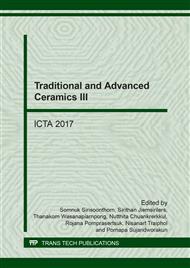p.241
p.246
p.252
p.258
p.264
p.270
p.276
p.282
p.288
Influence of Lignite Bottom Ash on Pyroplastic Deformation of Stoneware Ceramic Tiles
Abstract:
Electricity generation at Mae Moh Power Plant in Lampang, Thailand, uses lignite as fuel. The output is 3.0 to 3.5 million tons of fly ash per year and 1.5 to 2.0 million tons of bottom ash per year. Fly ash is widely used in concrete application but for bottom ash, it is not very useful. When considering the phase of bottom ash containing quartz, anorthite and hematite, it was found that there are suitable chemical compositions for replacement of raw materials in ceramic tile. Generally, the stoneware tiles are composed of quartz, mullite, feldspar, and glass phase. Water absorption of stoneware ceramic tiles is below 5%, high strength, fire resistance, and low warpage. Firing or sintering at rather high temperature as 1000-1250 °C is the manufacturing process for this type of tile. The changes in crystal structure and glassy phase formation in tile texture during sintering will be often result the tile to warpage or bent. The more or less lean depends on the viscosity of the glassy phase that occurs at high temperatures in the tile if less viscosity will cause higher warping rate that effect on the shape, and quality of the workpiece. The research has reported that anorthite phase improves the viscosity of a liquid phase or glassy phase when the tile is sintering at high temperatures and lead to high density and low water absorption. This research is interested in studying the effect of using lignite bottom ash as an ingredient in ceramic tile texture to produce low water absorption type by analyzing the effect of percentage of lignite bottom ash to warpage and important properties of ceramic tiles.
Info:
Periodical:
Pages:
264-269
Citation:
Online since:
April 2018
Keywords:
Price:
Сopyright:
© 2018 Trans Tech Publications Ltd. All Rights Reserved
Share:
Citation:


